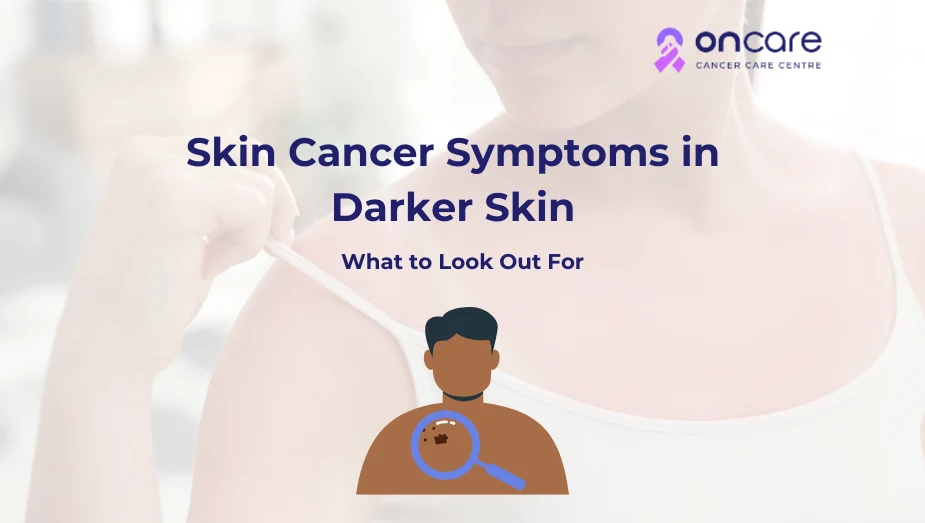Table of Contents
Skin Cancer Symptoms in Darker Skin: What to Look Out For

Skin cancer is a life-threatening disease. This disease is primarily thought to be a major health concern of light-colored complexions. But in reality, darker tones are not immune to this type of cancer. One of the major threats lies in the delayed diagnosis. In most cases, the symptoms get dismissed due to negligence or carelessness. If you are concerned about this type of cancer and how to identify skin cancer symptoms in dark-toned skin, then read further!
In this article, we’ll dive deep into the early symptoms of skin cancer and why this cancer in darker tones is generally missed—its reasons!
Why is skin cancer in darker tones not treated early?
There is a big misconception that this cancer is not common in darker tones. They are at low risk of developing this cancer. This type of cancer is often diagnosed in dark-colored people later than early. It makes this cancer very hard to treat.
People kept ignoring the symptoms of these cancers until they reached the advanced stage. Do not ignore the signs, or don't consider that all of these signs are related to any less serious health issue.
Why does this cancer in a darker tone get missed?
According to studies, melanin offers some natural protection against UV radiation and its exposure. However, it does not offer complete protection to escape from the risk of developing this type of cancer. In fact, many studies claim that this type of cancer often develops more in Black, Hispanic, and Asian individuals, who tend to experience more aggressive cancer and are often diagnosed in the late stages when compared to white people.
Here are some of the reasons that cause late diagnosis of this cancer in dark-toned people.
These may include:
- Believing misconceptions like having immunity to not develop this cancer
- Lack of regular skin screening tests
- Symptoms that appear in the non-exposed areas
- Lack of cancer awareness and recognition of warning signs
- Medical bias
Types of cancers in darker skin tones
There are three main types of skin cancer.
- Basal cell carcinoma: This type of cancer affects the basal cells in the lower part of the epidermis (this is an outer layer of the skin).
- Squamous cell carcinoma: This type of cancer develops in the squamous cells in the outside layer of the skin.
- Melanoma: This is the most serious type of cancer because it can spread to other areas of your body.
- Acral lentiginous melanoma: This is one of the most common melanoma developed in people with dark tone. It mostly appears on palms, soles of the feet, or under nails, which is not often related to sun exposure.
Early symptoms of skin cancer to watch out for in darker skin tones!
Unlike the fair-colored people, the symptoms of this cancer may not always appear as pigmented or red-colored wounds or moles in dark-toned people. Here are some of the early symptoms of skin cancer in dark skin tones.
These may include:
- New black or dark brown moles with irregular edges or growths
- Any types of sores that don’t heal (keep coming back)
- Experiencing dry or scaly patches
- Itchy skin
- Experiencing change in the moles
- New moles growing
- A sudden streaks or lines under the nails (especially black or brown lines)
- New growths in scars or wounds
- Chronic wounds
Top tips: Always pay close attention to the non-exposed areas such as:
- Palms
- Nail beds
- Mucous membranes (mouth, genitals)
Skin cancer prevention tips for darker skin
As we all know, prevention is better than cure, even though Dark tone’s risk of developing this cancer may be lower when compared to white skin tone. Still prevention matters!
Here’s how you can reduce the risk of skin cancer.
- Use sunscreen creams daily with SPF 50 or broad spectrum.
- Always wear protective clothes.
- Use wide-brimmed hats while outdoors.
- Avoid the use of tanning beds.
- Always check your body.
- Do not ignore any new moles or growths.
- Check your palms, soles, and toenails and fingernails.
- Get an early skin checkup annually.
When to consult a dermatologist?
If you experience any of these symptoms then schedule an appointment with a dermatologist immediately.
If you notice any changes such as:
- Any new, changing, or unusual skin growths
- A sore that doesn’t heal even after 3 weeks
- New mole with a changing color or size
- Experiencing dark streaks or discoloration under the nails
Consult Today
Skin cancer in darker tones can be less common; however, it can be more deadly due to delayed diagnosis. Understanding what to look for, performing regular skin screening checkups, and seeing a dermatologist early can save your life.
At Oncare, we offer premium-quality treatments including advanced cancer surgeries at affordable price ranges with an experienced cancer specialist consultation.
If you or any loved ones of yours are diagnosed with cancer, then visit Oncare Cancer Center and book an appointment with our cancer specialist. Get an estimated cost of your cancer treatments today!
Frequently Asked Questions
Consult a doctor immediately once you start to observe any change in the skin, especially when it's quite unusual or it doesn’t heal properly. Get a skin cancer screening to get a closer look at the cells.
Talk to your doctor about the risk of cancer, exposure to the sun and tone of your skin color, and some other factors that increase the risk of developing this cancer.
Consult a doctor if you see any unusual changes on your skin that do not get better in a one-month period.
- Check on the skin all around the body, even in your mouth.
- Observe any new mole or other growth on the skin.
- Check for changes in the appearance of an old growth on the skin or scar.
- Watch out for any skin change that is a different color than your usual type and starts to become darker.
- Observe any mole or sore that doesn’t heal easily, and it may start to bleed from the crust.
- Always observe your fingernails and toenails for any color change.
According to many studies, sunlight causes damage to the skin. This type of cancer can also be caused by the effect of ultraviolet rays, UV rays, also commonly known as UVB and UVA rays. There are some other medical conditions that can increase the risk of developing this cancer.
Anyone can get skin cancer; there’s no bias of color for developing this cancer. It is more common among people with a light or fair skin tone. This type of cancer can develop in anyone, no matter the color of the skin.

